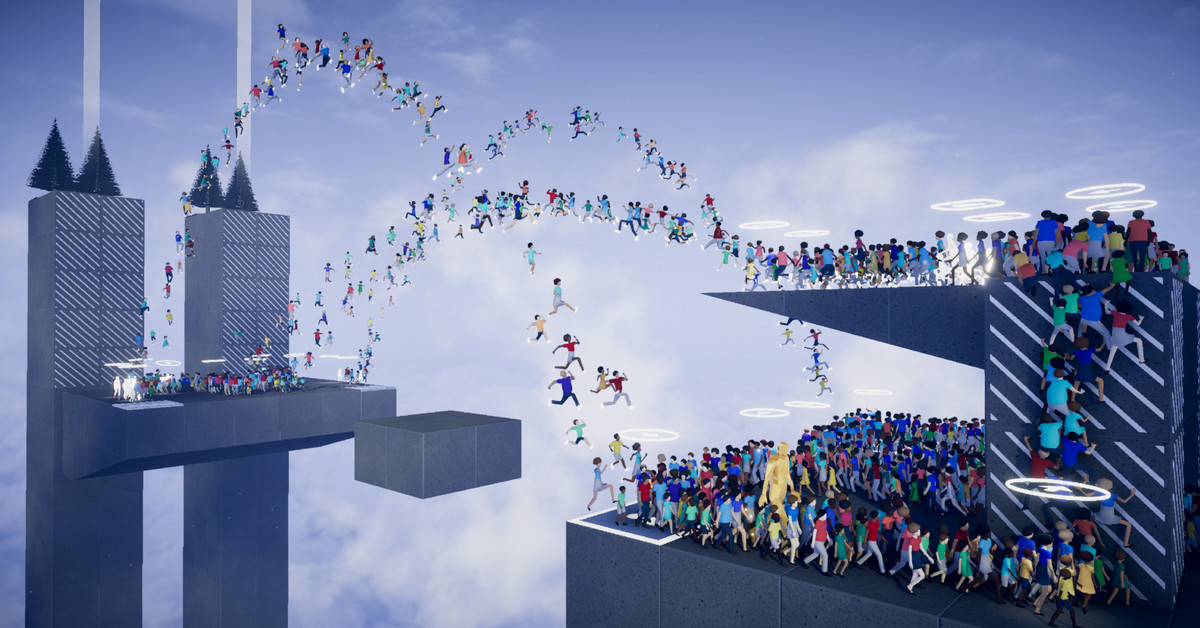/cdn.vox-cdn.com/uploads/chorus_asset/file/24611973/HUMANITY_03.png)
Some of the most memorable games in PlayStation history have been downright strange, whether about dancing wireframe rabbits, deadly cubes, or mannequins traversing impossible architecture. These “very designer-led games,” as Mark MacDonald from Tetris Effect studio Enhance describes them, were often iconic — but they’ve also largely fallen out of favor. That’s where Humanity comes in. It’s an introspective game about a dog guiding a sea of humanity through puzzle-like mazes, and it’s as odd as it is compelling, a callback to exactly those kinds of classic PlayStation experiences.
Humanity is a collaboration between Enhance — led by the legendary Tetsuya Mizuguchi, of Rez and Lumines fame — and designer Yugo Nakamura. Ahead of its launch on May 16th, I’ve been able to play around with the PS5 version (it’s also coming to the PS4 and Steam and will have VR support for all three platforms) and it’s the kind of game I can’t seem to get out of my head. It starts out simple. You see a Shiba Inu that’s glowing a blinding white that says, “I awoke one morning to find I was a dog.” You’re then given a straightforward instruction to “guide the people to the light.”
Essentially Humanity is a new take on Lemmings, where the goal is to guide huge crowds of mindless people to an end point. Each stage is a puzzle, and the humans will do nothing but walk in a straight line until they’re told any different, even if it means falling into oblivion. It’s your job to walk around and literally bark commands at them to get them where they need to be. Luckily, you don’t have to worry about death much, as the parade of humans is never-ending. All you need to do is issue the right commands.
a:hover]:text-gray-63 [&>a:hover]:shadow-underline-black dark:[&>a:hover]:text-gray-bd dark:[&>a:hover]:shadow-underline-gray [&>a]:shadow-underline-gray-63 dark:[&>a]:text-gray-bd dark:[&>a]:shadow-underline-gray”>Image: Enhance
Things start out easy enough. In the very first level, you can only issue three commands: turn (which causes the human swarm to change direction); regular jump; and high jump. As the dog, you run around the grid-like levels and place these commands where you need them in order to guide the mass of people to the glowing square that denotes the end. You’re free to experiment because, again, death doesn’t really matter. So if one path doesn’t work — say the people are jumping too far and head straight off a cliff — you can tweak as you go.
Another nice feature is the ability to restart the level with all of your current commands in place so you don’t have to begin again from scratch. Similarly, Humanity has a hint system that lets you simply watch a video playthrough of the level if you get stuck so you don’t have to take out your phone to watch walkthroughs in the middle of the game. “We know people will just go to YouTube anyways,” says MacDonald.
Naturally, things get much more complicated. In the first eight levels alone (which make up the game’s initial chapter), I encountered switches that alter the level layout, fans that blow people straight in the air, water that they can swim through, and new commands like “cloud,” which lets the humans jump farther and cushions the blow of a long fall. Each level also has a couple of “Goldies,” which are giant gold people that act sort of like the stars in Super Mario 64. You don’t have to get them to complete the level, but they are needed to progress past certain points. In order to unlock the final level of the first chapter, for example, I had to collect 10 of them.
From what I’ve played, Humanity is one of those games with a straightforward (if odd) premise that offers lots of room for creativity, both in terms of level design and player solutions. It’s also oddly beautiful, with a stripped-down visual style that leads to lots of surreal moments, like when you see floods of humans streaming through the air like water. As you get to the later stages, there are even things like boss battles and enemies to deal with as the game continually introduces new elements that force you to think and play in new ways.
a:hover]:text-gray-63 [&>a:hover]:shadow-underline-black dark:[&>a:hover]:text-gray-bd dark:[&>a:hover]:shadow-underline-gray [&>a]:shadow-underline-gray-63 dark:[&>a]:text-gray-bd dark:[&>a]:shadow-underline-gray”>Image: Enhance
And much like Tetris Effect, there’s also something of a story about, well, humanity. It’s not an explicit narrative full of cutscenes but, rather, implied storytelling through things like the chapter names (awakening, choice, etc.) and the themes of the levels. A big part of this is the dog itself — which wasn’t actually part of the original demo but made total sense once it was implemented. “When we first saw the demo there were no characters. Then out of nowhere [Nakamura] replaced the cursor with this dog,” Mizuguchi explains. “And it kind of completed the concept.”
Beyond the campaign from the developers, Humanity also has a robust level creator, which the team hopes will extend the game’s life. They got a taste of what to expect from the community after releasing a demo earlier this year. “We were all nervous,” Mizuguchi says. “We didn’t know what the response would be.” But as often happens with these kinds of games, players took to it with a creative fervor, building everything from strange versions of bowling and pachinko to a recreation of the intro to Metal Gear Solid. “That was just in a week,” adds MacDonald.
Whether the game takes off as a creative tool, Humanity’s campaign appears to succeed at its goal of channeling those PlayStation classics through a mix of distinct premise, clean visuals, and clever puzzles. I’ll have much more on the game as we get closer to launch in a few weeks.
Services Marketplace – Listings, Bookings & Reviews
